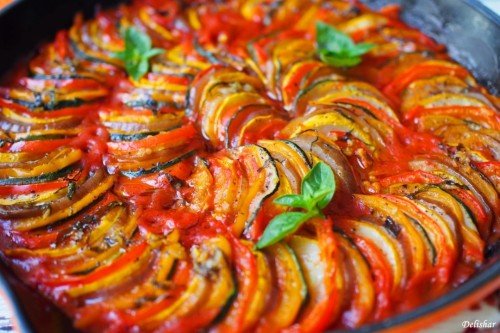
Ratatouille is a classic French vegetable stew that has been enjoyed for centuries. Its origins can be traced back to the region of Provence, located in the southeastern part of France, where it was traditionally made by peasants as a way to use up leftover vegetables. The dish has since become a staple of French cuisine and has been adapted in various ways around the world.
The name ratatouille comes from the French word "touiller," which means to toss or stir, and "ratouiller," which means to mix up. This reflects the way in which the dish is prepared, with a variety of vegetables being sautéed and then simmered together in a pot. The traditional ingredients of ratatouille include eggplant, zucchini, bell peppers, onions, and tomatoes, although there are many variations of the dish that include other vegetables as well.
Ratatouille has a long and interesting history that can be traced back to the region of Provence, France. The dish was originally a peasant food, as it was created as a way to use up leftover vegetables. The name of the dish comes from the French word "touiller," which means to toss or stir, and "ratouiller," which means to mix up. This reflects the way in which the dish is prepared, with a variety of vegetables being sautéed and then simmered together in a pot.
The exact origins of ratatouille are unclear, but it is believed that the dish dates back to the 18th century. At this time, the dish was primarily made with tomatoes, onions, and garlic, as these were the most readily available vegetables in the region. However, over time, other vegetables such as zucchini, eggplant, and bell peppers were added to the recipe.
In the 20th century, ratatouille became a popular dish throughout France, and it was eventually adopted by chefs around the world. Today, ratatouille is a staple of French cuisine and can be found in restaurants and homes across the country. It is also a popular vegetarian and vegan dish due to its use of a variety of vegetables.
Ratatouille gained even more recognition in popular culture when the 2007 Disney Pixar film of the same name was released. The film follows the story of a young rat named Remy who dreams of becoming a chef in Paris. He eventually teams up with a human chef named Linguini and together they create a dish of ratatouille that becomes a hit with critics and diners alike.
Overall, ratatouille is a beloved dish with a rich history and cultural significance. Its simple yet delicious recipe has stood the test of time and continues to be enjoyed by people all over the world.
One of the most famous adaptations of ratatouille came in 2007 with the release of the Disney Pixar movie of the same name. The film follows the story of a young rat named Remy who dreams of becoming a chef in Paris. He eventually teams up with a human chef named Linguini and together they create a dish of ratatouille that becomes a hit with critics and diners alike.
If you'd like to try making ratatouille at home, here's a simple recipe to get you started:
Ingredients:
- 1 large eggplant, diced
- 2 zucchinis, diced
- 2 bell peppers, diced
- 1 onion, diced
- 4 tomatoes, diced
- 4 cloves of garlic, minced
- 2 tablespoons of olive oil
- Salt and pepper to taste
- Fresh herbs, such as basil or thyme, for garnish (optional)
Instructions:
-
Heat the olive oil in a large pot over medium heat. Add the garlic and onion and sauté for 2-3 minutes until softened.
-
Add the eggplant, zucchini, and bell peppers to the pot and continue to sauté for 5-7 minutes until they begin to soften.
-
Add the tomatoes to the pot and stir everything together. Season with salt and pepper to taste.
-
Cover the pot and reduce the heat to low. Simmer the ratatouille for 20-30 minutes, stirring occasionally, until all the vegetables are cooked through and tender.
-
Garnish with fresh herbs if desired and serve hot.








